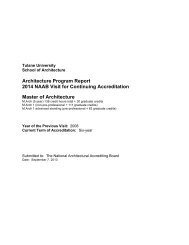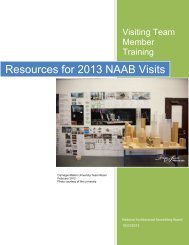Architecture Program Report Tulane University New Orleans ...
Architecture Program Report Tulane University New Orleans ...
Architecture Program Report Tulane University New Orleans ...
You also want an ePaper? Increase the reach of your titles
YUMPU automatically turns print PDFs into web optimized ePapers that Google loves.
discipline and practice.<br />
Second-year<br />
The pedagogical approach to second-year studio is based on the belief that<br />
constraints inherent in the design of architecture do not hinder the exploration of<br />
significant possibilities, but in fact allow and promote such activity. In this year,<br />
the studio addresses a range of issues fundamental to the discipline and practice<br />
of architecture. The pedagogy over the entire year is design as a sequentially<br />
coherent whole, with courses such as Digital Media II (CAD & Spatial Modeling)<br />
a required elective in the History of <strong>Architecture</strong>, and Technological Systems II<br />
taught simultaneously. This is also the year when undergraduate and graduate<br />
curricula overlap.<br />
The vehicle for Studio exploration is a series of building design projects with a<br />
range of program and site conditions. Each project focuses on specific<br />
architectural issues within a body of continuing concerns, including: the<br />
accommodation of activity or process, immediate and peripheral context; the<br />
definition and quality of space (interior and exterior); and structure and the use of<br />
materials. There are three fundamental criteria that each project represents: 1.<br />
Projects have a basis in realistic conditions outside of the particular concerns of<br />
architecture; site and programs relationships must be appropriate in terms of type<br />
and scale and programs must address existing needs in the community<br />
―considerations of use are paramount, 2. Projects are initiated through the<br />
extensive documentation and analysis of site―“what is found there,” and 3.<br />
Projects are viewed in the context of other built, proposed and paper<br />
architecture.<br />
In the Second-year, students are also introduced to the History and Theory<br />
sequence of the curriculum (AHST 110). While prerequisite introductory courses<br />
(History of <strong>Architecture</strong> I for undergraduates and History of <strong>Architecture</strong> I/II for<br />
graduates) present various ideas associated with the study of architectural<br />
history and theory, the continuation of the sequence focuses on criticism and<br />
research methodologies associated with history and theory: one required Period<br />
elective spanning Ancient to 19 th -century (AHST 310, 311, 312, 313) and the<br />
required Modern <strong>Architecture</strong> course (either AHST 320 or 321).<br />
Students in the School of <strong>Architecture</strong> thus enroll in a three-semester sequence<br />
of courses on the History of Western <strong>Architecture</strong>. The introductory survey for<br />
undergraduates presents a Global History of <strong>Architecture</strong>. And given the nature<br />
of the period and modern electives, students may take courses that are<br />
significantly global, such as World Heritage Sites I (Gonzalez) or largely<br />
grounded in the Western tradition, such as 19 th -century <strong>Architecture</strong> (Gamard).<br />
The presentation of other cultural traditions, and more particularly, the<br />
architecture and urban design associated with non-Western traditions, has<br />
steadily increased in the past several years.<br />
The History courses are chronologically structured and provide the student with a<br />
thorough historical armature on which to build a view of the history of<br />
architecture. While it is true that the material could be critiqued for its














